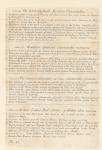

 165. The Barberry Bush. Berberis, Oxyacantha.
165. The Barberry Bush. Berberis, Oxyacantha.
1. It seldom grows to any great Bigness, the Leaves are a fine grass Green, the Flowers yellow and the Berries red.
2. In some Parts they grow wild, and are also planted in Gardens, flowring in May; the Berries being ripe in September.
3. The Inner Bark of this Bush is accounted a Specific for the Yellow Jaundice, either taken in an Infusion or Decoction; being opening and attenuating. The Berries are good to moisten the Mouth and quench Thirst in Burning Fevers, being cooling & restringent. The Conserve is serviceable against all kinds of Looseness, Fluxes & ye Jaundice. - The Seed is esteem'd binding & restringent. The officinal Preparation is the Conserve of the Fruit.
4. Greek, Οξυακανθα. Latin, Oxyacantha. Spanish, . Italian, Crespino. French, Vinette. German, Bersich. Dutch, Berberisse.

 166. Mountain Calamint. Calamentha montana.
166. Mountain Calamint. Calamentha montana.
1. It grows to be a Foot high, the Leaves are a deep Green, & ye Flowers a pale Purple.
2. There are two sorts of this Calamint found in Kent in great Plenty; growing by Hedges, and flowring in Iune and Iuly.
3. This Calamint is hotter than common Mint, being a good Stomatic, expelling Wind, and helping the Collic. It is of great Service to the Female Sex, in Obstructions of the Catamenia, bringing them to a regular Course; this it does, taken inwardly, or by a strong Decoction given as a Glyster. The officinal Preparation is the Pulo Diacal. Simplex.
4. Greek, Καλαμιθα ογινη. Latin, Calamentha vulgaris montana. Spanish, Neveda. Italian, Nipotella montana. French, Pouillio de montagnes. German, Bergmunt. Dutch, Calamenth.

 167. The Common Calamint of the Shops. Calamentha officinalis.
167. The Common Calamint of the Shops. Calamentha officinalis.
1. This Calamint is much like the former, only this lyes much upon the Ground, and the Leaves are smaller, the Leaves and Flowers are alike in Colour to the former.
2. It grows in like Places as the former, but flowers in Iuly and August.
3. It has much the same Vertues as the other, being opening and deobstruent, and is used often for the other, because it grows in greater Plenty, and the Shops are mostly Supplied with this.
4. Greek, Καλαμινυα. Latin, Calamentha officinalis, or Pulegu odore Nepeta. Spanish, Neveda. Italian, Calamenta. French, Poullio sauvage. German, Bilder polen. Dutch, Berg Calamenth.

 168. White Ladies-Bed-Straw. Gallium album latefolium.
168. White Ladies-Bed-Straw. Gallium album latefolium.
Also see #039, Clivers - #060, Wood-roof - #168, White Ladies-Bed-Straw.
1. It grows to be two Foot high, the Leaves are a grass Green, and the Flowers White.
2. It grows on Banks and dry barren Places, flowring in Iune and Iuly.
3. This Plant is esteem'd drying and incrassating, good to stop all kinds of Fluxes and Haemorrhagies, and cure Wounds. Some commend a Decoction of it for the Gout and a Bath made of it to refresh ye Feet when tired with overwalking. In the North they use this Plant instead of Rennet in making their Cheeses.
4. Greek, Γαλιον. Latin, Gallium. Spanish, Coaja Leche Yerva. Italian, Galio. French, Petit Muguet. German, Weger Craut. Dutch, .

